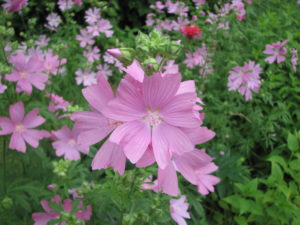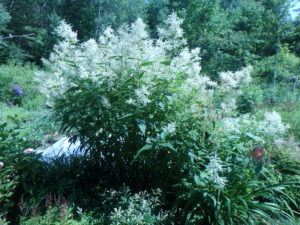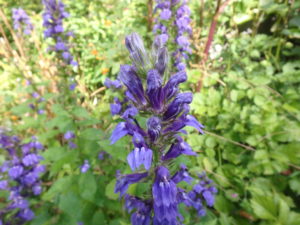Garden Thugs to Love or Hate
Just coming in to bloom for me right now is pink or hollyhock mallow (Malva alcea). Each plant presents lots of bright pink blossoms over several weeks that are about 1½ inches wide. She is generous, offering babies that mysteriously pop up all over my garden. There is a big clump blooming in my vegetable garden right now that I definitely did not plant.
Pink mallow grows to be 3 to 4 feet tall and 18 inches wide when grown in full sun. It is drought tolerant and not fussy about soil. It does tend to flop, however, so it often needs to be staked. It has a fleshy root and hates to be moved except when very young.
Beebalm (Monarda didyma) is one of my favorites, despite the fact that it spreads by root and cannot be contained. The blossoms are large and fragrant, and it is an excellent cut flower.
Beebalm is a tall plant (mine are 3 to 5 feet tall) on square stems. I have it planted up against a rock wall and fronted by a lawn, so it is contained on 2 sides. A lawnmower is a very effective tool against the spread of any flower. The good news is this: it is very easy to pull out volunteers.
Many gardening books list beebalm as a “full-sun” plant. My books do not. I recommend planting it where it gets morning sun only. I have found that full sun dries it out too quickly and reduces its bloom time and beauty. Hot afternoon sun is often too strong for this plant, particularly in sandy soils. For me it grows and blooms in quite shady places, and loves moist soil.
The “common” orange daylily (Hemerocallis fulva) is frequently disparaged by gardeners, but not by me. It really will grow anywhere, in any soil and is not deterred by bugs, slugs or predatory herbivores. Or at least not in my experience. I once dug out a clump from a flower bed at the end of the day and dropped it on the lawn. At the time I was an electrician working long hours all week and gardening only on weekends. By the next weekend it had dug its fingers into the soil (Okay, its roots) and I left it there. Now 20 years later it is still there and beautiful when it blooms.
The fancy varieties of daylilies stay in a nice clump that get bigger each year, but don’t really spread. The orange one does spread by root, and can be difficult to contain. But I have some growing right by the road in shade and truly awful soil, and they will be blooming shortly. I also have a double orange that spreads by root, but is a bit flashier.
A plant you might not know is giant fleeceflower (Persicaria polymorpha). It is quite wonderful – it can get to be 8 to 10 feet tall with white fleecy flowers that persist much of the summer . It thrives in full sun and moist soil, but will grow almost anywhere.
Why might some consider it a thug? It gets bigger and the clump gets wider every year. And if you do not discipline it, it may well steam-roller favorite plants nearby. It has an amazing root system that will challenge most gardeners. So be sure you have a 6- to 8-foot wide space for it to dominate.
You probably know lobelia as a short annual plant (Lobelia erinus) that has intense blue or purple flowers and will bloom even in shade. Or perhaps you grow cardinal flower (L. cardinalis), a tall bright red, late-summer bloomer in wet places. But it has a cousin in the same genus that is a perennial with a wanderlust. Great blue lobelia (Lobelia siphilitica) is a great plant that moves around my garden at will. And I let it grow wherever it shows up.
Like cardinal flower, great blue lobelia is a vertical plant with blossoms along its stem. It stands about 2 to 3 feet tall and blooms in August. It does well in moist soil, but I also find it in hot, dry places. It pulls easily if it grows where you don’t want it. There is also a white form, but it is not a clean white.
I know that many gardeners love lily-of-the-valley (Convallaria majalis) for its sweet fragrance. I consider it a thug as it spreads by root and is hard to remove. I was recently given one with striped green and white leaves, and have planted it in a raised wood-sided bed so I can see if it tries to take over. The foliage is very attractive, and generally plants with white in their leaves are less aggressive. If it behaves well, it will earn a spot in my garden.
Each of us has a different level of acceptance for flowers that spread or move around. I love the spontaneity of many of the flowers I mentioned here.
Henry can be reached at henry.homeyer@comcast.net. He is the author of 4 gardening books.





